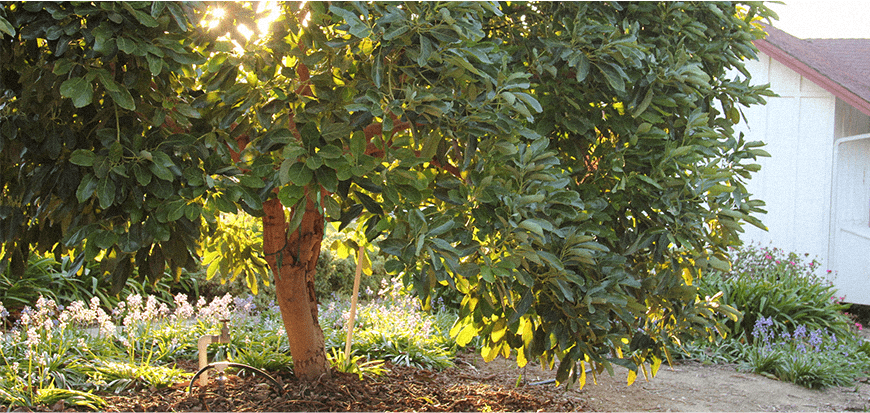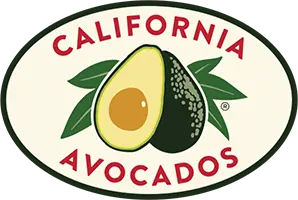
As with all fruits and vegetables, wash avocados before cutting. Check out our tips for how to choose and use California Avocados
Everything you need to know about how to grow an avocado tree. Really!
Everything you need to know about how to grow an avocado tree. Really! Want your own avocado tree or houseplant? There are a few ways to do it. This comprehensive guide tells you all you need to know, whether you’re starting from a seed or planting a young tree.
How to Grow an Avocado Tree from a Seed
- You can start with an avocado seed. Wash it
- Use three toothpicks to suspend it broad end down over a water-filled glass to cover about an inch of the seed.
- Put the glass in a warm place out of direct sunlight and replenish water as needed. You should see the roots and stem start to sprout in about two to six weeks. (If you’ve followed this process so far and have not seen roots or a stem sprout in more than six to eight weeks, try another seed.)
- When the stem is 6 to 7 inches long, cut it back to about 3 inches
- When the roots are thick and the stem has leaves again, plant it in a rich humus soil in a 10½-inch-diameter pot, leaving the seed half exposed.
- Water it frequently, with an occasional deep soak. The soil should be moist but not saturated. And don’t forget: the more sunlight, the better
- When the stem is 12 inches high, cut it back to 6 inches to encourage the growth of new shoots.
Tip: If the plant turns yellow, you may be over-watering; let it dry out for a few days. If the leaves turn brown and fry at the tips, too much salt has accumulated in the soil. Let water run freely into the pot, and drain it for several minutes.
Planting: Young tree
Remember that avocado trees do best at moderately warm temperatures (60 F to 85 F) with moderate humidity. They can tolerate temperatures, once established, of around 28 F to 32 F with minimal damage. Avoid freezing temperatures. Plant your tree in March through June. If you plant during the summer, there is always the risk of sun damage, because avocado trees don’t absorb water very well when they’re young. Plant it in a non-lawn area and away from sidewalks and, if you can, plant it in a spot protected from wind and frost. Remember, full sun is best. Dig a hole as deep as the current root ball and just as wide as the width plus a little extra so you can get your hands into the hole to plant it. The avocado is a shallow-rooted tree with most of its feeder roots in the top 6 inches of soil, so give it good aeration. Its root system is very sensitive, and great care should be taken not to disturb it when transplanting. If the tree is root-bound, however, loosen up the soil around the edges and clip the roots that are going in circles.
Soil
Avocado trees like the soil’s pH around 6 to 6.5. If you have a heavy clay soil, elevate the tree in a mound for better drainage. Make the mound 1 to 2 feet high and 3 to 5 feet around. Don’t put gravel or anything else like planting media in the hole. The sooner the roots get into the bulk soil, the better the tree will do.
Watering
Trees typically need to be watered two to three times a week. As the roots reach out into the bulk soil, more water can be applied and the frequency of watering can diminish to about once a week after a year. When watering the tree, soak the soil well, and then allow it to dry out somewhat before watering again. As with most plants, you don’t want the tree to get too dry. The rule of thumb for mature trees is about 20 gallons of water a day during the irrigation season. Seedlings will require quite a bit less water, of course. Check the soil before watering each time to make sure it has dried somewhat. If the soil from around the roots can hold the impression of a hand when squeezed, it has enough water.
Mulching and Fertilizing
Mulch with coarse yard mulch. Redwood bark or cocoa bean husks and shredded tree bark will work. Choose something that is woody and about 2 inches in diameter. Coarse yard mulch is available at some garden-supply centers and through tree-trimming operations. Tree-trimming operations sometimes have material that has been pruned from the tops of trees and doesn’t contain any diseased roots. Use online search engines to find a local tree service. Put 20 pounds of gypsum spread around the tree base, and mulch the area with 6 inches of mulch, keeping the material about 6 to 8 inches away from the tree trunk. Fertilize your young avocado trees with ½ to 1 pound of actual nitrogen per tree per year. You can spread it out over several applications as long as it totals ½ to 1 pound of nitrogen. The other important nutrient for avocado trees is zinc. Ordinary home fertilizer for houseplants will normally work.
Other growing tips
Be patient about seeing fruit. If you have purchased and planted a tree, you can probably expect to see your first fruit three to four years after planting. If you are growing from a seed, it can take anywhere from five to 13 years before the tree is mature enough to set fruit. When the tree does flower, expect a lot of flowers to fall without setting fruit. This is natural.
FAQs and Troubleshooting
Should I plant a “B” type avocado with an “A” type avocado to help with good pollination?
Avocado flowering patterns fall into two groups: “A” type and “B” type flowers. A-type flowers open female in the morning and male in the afternoon, B-type are male in the morning and female in the afternoon.
It is widely accepted that fruit production can be helped with the presence of another avocado variety, but it isn’t always required.
How does temperature influence pollination and fruit set?
Optimum fruit set occurs at temperatures between about 65 – 75 F. Cooler or warmer temperatures are less ideal.
Under some conditions, you may get a fruit from a flower that did not pollinate properly. These small, elongated fruit will often fall from the tree on their own, but if they “hang on” you can pick them and eat them. These fruit are called “cukes” but are sometimes marketed in stores as “Cocktail” or “Finger” avocados.
What can I do about my avocado tree dropping fruit?
This is called fruit drop. An avocado tree typically produces about one million flowers, but only 100-200 pieces of fruit per tree. In other words, 1 fruit in 10,000 will set and mature. Sometimes the tree will set fruit but drop them when they are pea to walnut size. This is typical.
To minimize fruit drop of good “fertilized” fruit, avoid stressing the tree. Don’t under or overwater it. Research suggests that fruit retention is also better when there are other avocado varieties present to provide cross-pollination, and that these crossed fruit have a higher tendency to stay on the tree.
There is also some indication that over-fertilizing with Nitrogen during the early fruit stages can also somewhat influence fruit drop. Check with your master gardener for help with fertilizers for your climate/location.
How can I tell when my avocados are ripe and ready to pick?
Avocados do not “ripen” on the tree, that is, they do not get soft while on the tree. They mature on the tree.
Once you pick an avocado, it can take from 7-21 days for it to soften when left at room temperature. You can speed the process up slightly by placing the avocado in a bag with some other ripe fruit (like an apple or banana) or slow the process down by keeping the fruit in the refrigerator. More on how to ripen avocados.
So, when should I pick my avocados?
Pick a couple of avocados and try to ripen them. If they shrivel up or seem rubbery instead of soft, they are not mature yet. Keep picking fruit every few weeks. Note on the calendar when they soften instead of turning rubbery.
Also, note the taste of the fruit. The oil content of the fruit usually increases through the season, and there will be a certain point when it tastes “just right.” That date will usually vary somewhat due to climate conditions, and some years will be better than others. Some varieties can also reach a point where they have too much oil and some will turn rancid (although many types fall from the tree before reaching that point).
The Hass Avocado in California typically comes to maturity in February and is good through September or October. These dates depend a lot on where you live and climate conditions.
How many fruit will a mature tree produce in one year?
It is possible for an avocado tree to produce 200 to 300 fruit per tree once it is about 5-7 years of age. The avocado tree, however, alternates bearing. This means that the tree may produce a large crop one year, and then produce a small crop the following year. There are lots of variables that influence this.
How many years will a normal avocado tree produce fruit?
Typically, an avocado tree will continue to grow and produce fruit until something kills the tree.
When is the best time to prune avocado trees?
Avocados can be pruned any time of the year, but there tends to be less vigorous regrowth if it is done after cold weather in the winter, sometime around February.
How large will my avocado tree get?
Growth is reflected in rootstock, variety, soil depth and texture, windiness, irrigation and pruning. Reed, Bacon and Hass trees can ultimately grow to 35 feet in 30 years. Pruning can keep the trees to a manageable size, under 15 feet, but it must be done on a regular basis.
What’s the creamy-white foamy looking stuff that grows out of the bark where there are cuts, or small branches have died and dropped off?
It is just sap coming from a wound. It dries into that sugary white, fluffy stuff.
What areas of California are most hospitable to avocados?
Most areas of Southern California are suitable for avocados, except for the mountains and high deserts, where it gets too cold and too dry for fruit set. Outside of Southern California, it depends on the climate. Cold is most often the problem faced in other parts of the state. Still, there are home growers with avocado trees in and around San Francisco. There is also an area along the foothills of the Sierra Nevada Mountains where avocados are being grown in Fresno and Tulare Counties. Growing areas in Southern California include:
- San Diego County
- Orange County
- Los Angeles County
- Riverside County
- Western San Bernardino County
- Ventura County
- Santa Barbara County
- Some parts of San Luis Obispo and Santa Cruz Counties
More Resources
Not finding what you are looking for? Contact a master gardener* or see the below resources. All links open a new window:
- Tips for the Backyard Avocado Grower (PDF)
This sheet, developed by the California Avocado Commission, was designed to provide Do-It-Yourself tips on growing an avocado tree - Ventura County Avocado Handbook*
This helpful handbook, hosted by the University of California Cooperative Extension, provides text book-like information on growing an avocado tree including grafting, planting, flowering and more - Growing Avocados (YouTube)*
YouTube offers a helpful selection of avocado growing tips and videos from avocado enthusiasts all over the world - Avocado Source*
The free, virtual library of avocado knowledge. Search for documents, research and more - Avocado Variety Information*
Almost 1,000 varieties of avocados are identified on this page. Also available through this site is general avocado information, resources on flowering, irrigation, phenology and rootstocks
For cultural advice on your avocado tree or plant, please contact a master gardener* or nursery nearest you.
For assistance over the phone from a Master Gardner, try one of the following hotlines:
| LOS ANGELES | 323-260-3238 |
| ORANGE COUNTY | 714-708-1646 |
| SAN DIEGO | 858-694-2860 |
| SAN LUIS OBISPO | 805-781-5939 or 805-781-1429 |
| SANTA BARBARA | (805) 781-5940 |
| SANTA CLARA | 408-299-2636 |
| VENTURA | 805-645-1455 |
The California Avocado Commission does not sell, produce or have avocados, seeds or trees available for purchase. For information on where avocado trees are sold, please contact a nursery nearest you.
* Please note: The California Avocado Commission provides this information as a convenience to you; it should not be considered an endorsement by the Commission of a third-party website or the company who owns it. The Commission is not responsible for the quality, safety, completeness, or accuracy or nature of the content of the linked websites.


Comments